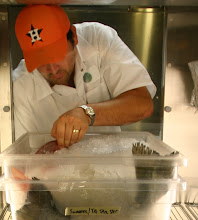
If you have ever read this blog, or you and I have had drinks that spilled into a long night of me lamenting my long lost youth, then you’ve heard me talk about the white van with S H R I M P written on the side that used to crawl through my old neighborhood, honking every fifth or sixth house. Well, folks, my chariot has returned.

Gulf White Shrimp, (Penaeus Setiferus) is one of the three main commercial species of trawled shrimp in the Gulf of Mexico. If you’ve ever had fresh, never frozen, head-on shrimp then you know the difference from the normal shrimp routine. These are soft, meaty, toothy (but not rubbery), like a small steak from the sea. It’s like the difference between concentrate OJ vs. freshly-squeezed: immediate, obvious, worlds apart.
Fresh White Shrimp
White shrimp spawn in the Gulf with females releasing about 100,000 – 1,000,000 eggs that hatch with in 24 hours. They are then carried shoreward by the Gulf’s wind and currents and, in that time, they are a whopping quarter-inch long. They migrate into the inner bays, creeks and marshes, necessary protection for their survival and growth. An omnivorous species, they have an incredibly rapid growth rate of .04 to .09 inches per day. When they reach about 3-5 inches, they move back out into the bays and Gulf to start the process all over again. Commercially, Gulf shrimp are considered an annual crop with a lifespan of less than a year.
White shrimp spawn in the Gulf with females releasing about 100,000 – 1,000,000 eggs that hatch with in 24 hours. They are then carried shoreward by the Gulf’s wind and currents and, in that time, they are a whopping quarter-inch long. They migrate into the inner bays, creeks and marshes, necessary protection for their survival and growth. An omnivorous species, they have an incredibly rapid growth rate of .04 to .09 inches per day. When they reach about 3-5 inches, they move back out into the bays and Gulf to start the process all over again. Commercially, Gulf shrimp are considered an annual crop with a lifespan of less than a year.
There is a dark underbelly to these soft, white beauties, though. I know that. And an eternal struggle rages within my mind and heart. I often feel like a walking dichotomy, a contradiction of morality, views and beliefs. And shrimp are the perfect example of what tears me in two.
Shrimping is the largest commercial fishery in Texas, yielding almost 236 million pounds per year. Shrimp cost me around $6.50/pound for the 16-20's (a sizing reference, 16-20 shrimp in a pound) – so you do the math. Trawling for shrimp, like gillnets, hoopnets, longlining or fishing with dynamite, is an indiscriminate killer. Those that fall within its clinches don’t have much of a chance, becoming by-catch. By some estimates, shrimping in the Gulf affects 450 groups of organisms. An average haul consists of 67% finfish, 16% shrimp and 17% invertebrates. That equates to 4-8 pounds of fish that are killed to catch one pound of shrimp. If this was the Majors, the Shrimper’s would be getting bounced to the bush league, only batting .170. Most of this by-catch gets dumped back over the side; this I know first-hand because many fishermen take advantage of this buffet/chum line by drift fishing off the back of culling shrimp boats. The larger pelagic species also benefit, especially the King of the Gulf, the Dolphin. Unfortunately, there are no viable outlets for this by-catch, although both fertilizer and food seem to be logical choices.
Since 1995, the State of Texas has implemented an aggressive license buy-back program and (since January of this year) has bought back 1,978 licenses in an effort to control the ill effects of shrimping and bring it to a more manageable state. The mandatory use of TEDs (Turtle Exclusion Devices) and BRDs (Bycatch Reduction Devices) on trawlers has proven to work when used correctly. I think that those improvements, along with a focus on closures during growth periods to ensure spawning and eliminating bay and estuary shrimping, would ensure healthy stocks and a reduction in by-catch.
Now on to the food!
Recently, I bought about 25 Comals (cast iron Fajita platters) from this dude who was going out of business; ever since, I’ve been looking for an excuse to use them (#howadishisborn). Three weeks ago, I was drifting a gas well offshore, thinking back to my high school summer days, working in the gas fields in South Texas (Goliad, Yorktown, Weesatche, Victoria). The gas would come out of the ground at such a high pressure that it would sometimes cause icicles to form on the well head, even in 100 degree heat. So it had to cycle through a heater in order to warm it up, causing it to condensate and transform it into liquid form. A gin-clear fuel. The plate with the Shrimp and Pink Sea Bream “Salad” is placed on the ripping hot Comal, we pour Dashi on the Comal and then cover it with a dome, causing the Dashi to evaporate and then rain back down on the salad.








2 comments:
Thanks for the good read as a life raft repack station that services our shrimpers we are proud to support the Gulf shrimp industry and there is nothing better than fresh never frozen shrimp =)
Wow, I'd love to have a mysterious "SHRIMP" van trawling my neighborhood! I found your blog while looking around for information on the seasonality of white and brown shrimp (the latter which I'm familiar with, having grown up with Carolina families).
Post a Comment